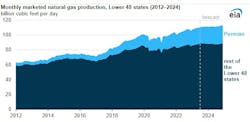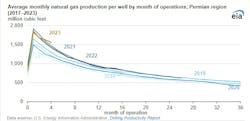EIA: US natural gas production to grow on high Permian well productivity, crude oil prices
In its latest Short-Term Energy Outlook, the US Energy Information Administration (EIA) projects that natural gas production in the Lower 48 states of the US will grow by 5% (5 bcfd) in 2023 and 2% (1.8 bcfd) in 2024. The primary driver of this forecasted growth is the Permian basin region, where EIA expects that improved well-level productivity and higher crude oil prices will spur drilling activity that will increase natural gas production.
The Permian basin region currently accounts for a quarter of all marketed natural gas production in the Lower 48. EIA forecasts that natural gas production in the region will increase by 11% (2.2 bcfd) in 2023 and 6% (1.4 bcfd) in 2024.
Most of the natural gas production in the Permian basin is associated natural gas production from oil wells. As a result, producers in the region typically respond to changes in the crude oil price when planning their exploration and production activities, including when deciding whether to deploy drilling rigs or take rigs out of operation.
“Advances in hydraulic fracturing and horizontal drilling techniques have improved US oil and natural gas well productivity. The length of a well’s horizontal section, or lateral, which is a key factor in well-level productivity, has increased substantially for wells operating in the Permian region, from an average of less than 4,000 ft in 2010 to over 10,000 ft in 2022,” EIA said.
EIA evaluates natural gas well productivity based on a well's monthly average natural gas output. “In its first full month of operation, a well typically produces the most natural gas, followed by declining output in subsequent months. Permian region wells that have started operations so far in 2023 have produced on average 1.85 bcf of natural gas during their first full month of operations. Average first month production for Permian region wells has risen in recent years, averaging 1.83 bcf in 2022 compared with 1.3 bcf in 2017,” EIA said.
So far in 2023, natural gas production has increased in the Permian basin region even as the rig count has decreased. According to Baker Hughes, 322 active rigs were operating in the Permian basin as of Sept. 15, 31 fewer than at the start of the year.
EIA forecasts the price of WTI crude oil will increase in 2024, averaging $83.22/bbl compared with $79.65/bbl in 2023, partly because of Saudi Arabia’s extended crude oil production cuts. EIA expects that the higher crude oil prices will incentivize operators to produce more oil and, as a result, more natural gas in the Permian basin region.

